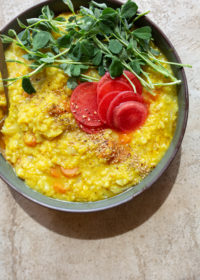Ayurveda: Rasa – The Six Tastes of Ayurveda | Pungent
This guest post from Adena Rose Ayurveda is part of a six part series on the essential tastes of Ayurveda – catch the other 5 tastes here!
2014 is the year of food as medicine, I declare. Here in the U.S. at least, our food has been so manipulated, so stripped of nutrients and real stuff that it takes a lot of time and effort to get what the body needs. The mouth taste, or rasa, of food and herbs is the crux of using food as medicine in Ayurveda. The tongue is not only meant for pleasurable experiences, but brings in all sorts of information. In Ayurvedic medicine, we use 6 tastes, and those 6 tastes cause our physiology to act in a certain way.
I last wrote in March about Lavana, or the Salty taste, and how it affects our physiology and beyond. Any substance may be used as medicine when we understand its qualities.
 Taste is a signifier of how the substance will affect our bodies. Ayurveda explains that there are six tastes: Sweet, Sour, Salty, Pungent, Bitter and Astringent. Some of these may seem obvious, and others more enigmatic. Each of the tastes is also comprised of the five elements, two which are the most dominant. This means that the tastes affect the doshas, Vata, Pitta and Kapha, which are also made of the 5 elements. You can use the chart below to see which tastes ‘subdue’ which doshas, and which elements each taste contains. In Ayurveda, like increases like. If we want to lessen the effects of a dosha which is showing up as too high, we will eat foods with the tastes that have elements which are not the same as those in the dosha which is out of whack – those ‘subdue’ the dosha.
Taste is a signifier of how the substance will affect our bodies. Ayurveda explains that there are six tastes: Sweet, Sour, Salty, Pungent, Bitter and Astringent. Some of these may seem obvious, and others more enigmatic. Each of the tastes is also comprised of the five elements, two which are the most dominant. This means that the tastes affect the doshas, Vata, Pitta and Kapha, which are also made of the 5 elements. You can use the chart below to see which tastes ‘subdue’ which doshas, and which elements each taste contains. In Ayurveda, like increases like. If we want to lessen the effects of a dosha which is showing up as too high, we will eat foods with the tastes that have elements which are not the same as those in the dosha which is out of whack – those ‘subdue’ the dosha.
Beyond the tastes, of course we want to ingest food full of prana, the life-force energy, and we also want to be sure we are chewing our food slowly, and digesting it fully. Those topics are beyond this post for now, but you can find general Ayurvedic tips for optimal digestion on my blog.
KATU : PUNGENT
Alas, it’s almost mid-May, and time to watch your intake of pungent taste. Pungent, of course, is spicy and hot, there are many different levels of ‘hot’ and spice. You know, mild, medium and hot, right?
This year more than ever I’ve been eating what Mother Nature is providing. Lucky to be up here in Vermont, she’s providing so many GREENS. I can’t wait to talk about Bitter and Astringent tastes next – perfect for Spring and Summer. Another green we’re getting here in Vermont is one of the first, and it’s just about past it’s prime: Wild Ramps. Ramps, also called leeks, also called ‘winooski’ by the Abenaki, are wild spring onions with a garlic-y kick. Pungent. Perfect for clearing the last bits of Kapha from a long dark winter and a cold damp “Spring.” (NOTE: Unless you find them wild, do not buy them from a grocery store or restaurant, as this is a delicate food that should not be over-harvested and shipped ANYWHERE. Don’t support that practice, even though they are so gorgeous and delicious – just come visit me in Vermont in early May! )
That brings me back to pungent, and the medicinal value of heat. The Katu taste warms the stomach, increases the appetite, warms the blood, and stimulates the senses. Foods often have antibacterial or anti-parasitical powers. These herbs and foods can cause sweating, and they are depleting to the tissues, so should be used moderately in Kapha individuals, and medicinally in Vata and Pittas.
Pungent foods are mainly used in small amounts, to improve digestion (agni) and absorption. Of course, pungent can aggravate digestion as well, if your system is already over-heating. Pungent, or Katu in Sanskrit, contains mainly Fire (duh) and Air elements. The Pitta dosha is mainly Fire, and the Vata dosha is mostly Air. Pungent foods and spices can aggravate both of these doshas – particularly Pitta. Vata’s can use spice with care, as it is by nature cold, and needs heat to stay balanced. To go a bit deeper – to correct a Vata plus ama (toxin) imbalance, pungent herbs or spices would most definitely be favored to assist in ‘burning up’ the toxins present.
Pungent brings excess Kapha into balance. The hot, dry and light qualities in pungent ingredients clear heavy, cold, and damp Kapha. As late winter and early spring are said to have qualities of Kapha, this is the best time of year to favor the heat (and right when the wild ramps show up!)
If you’re doing a seasonal cleanse this time of year, juicing and raw foods is not the way to go. That Kapha element is moving on up and out in nature (think rushing, overflowing rivers, and expanding, dank earth, aka mud) and it’s doing the same in your physiology. Kapha is present in our mucus membranes (lungs, joints, sinuses) and if there is a build up, that’s when we come down with heavy chest colds, allergies, sluggishness even types of depression. Adding more cold, sweet things, will only aggravate that condition. So in a Spring cleanse, on should to stir it up, heat it up, and lighten up with hot soups, curries and yes, a spicy masala kitchari, of course. Email me for a recipe.
Pungent foods and spices can aggravate Pitta, but as they contain a lot of the fire element, they also improve agni, or our digestive fire. There are two important ways to use pungent spices or herbs: deepana, or pachana. Deepana means to specifically enkindle agni, and pachana directly burns up ama, or toxins. Deepana spices are taken about 20 minutes before a meal, and encourage digestive enzymes (agni) to flow. Simple deepana include ginger/salt/lime digestive blend, or just ginger tea. Dried ginger, chilies, garlic, asafoetida, and black pepper can be used within or after a meal. They will assist in the digestion of your food, but also to stick around in the stomach afterwards and do a little clean up. A popular and less spicy pachana tea blend is to use cumin, coriander and fennel seeds.
If you’ve made it this far, you probably noticed I wasn’t afraid to throw a lot of Sanskrit at you! As always with Ayurveda, it’s a personal exploration, as we are all individuals. Perhaps this will inspire you to take a little more time to you chew your lunch today. What do you taste?
—–


 [wpmenucart]
[wpmenucart]


